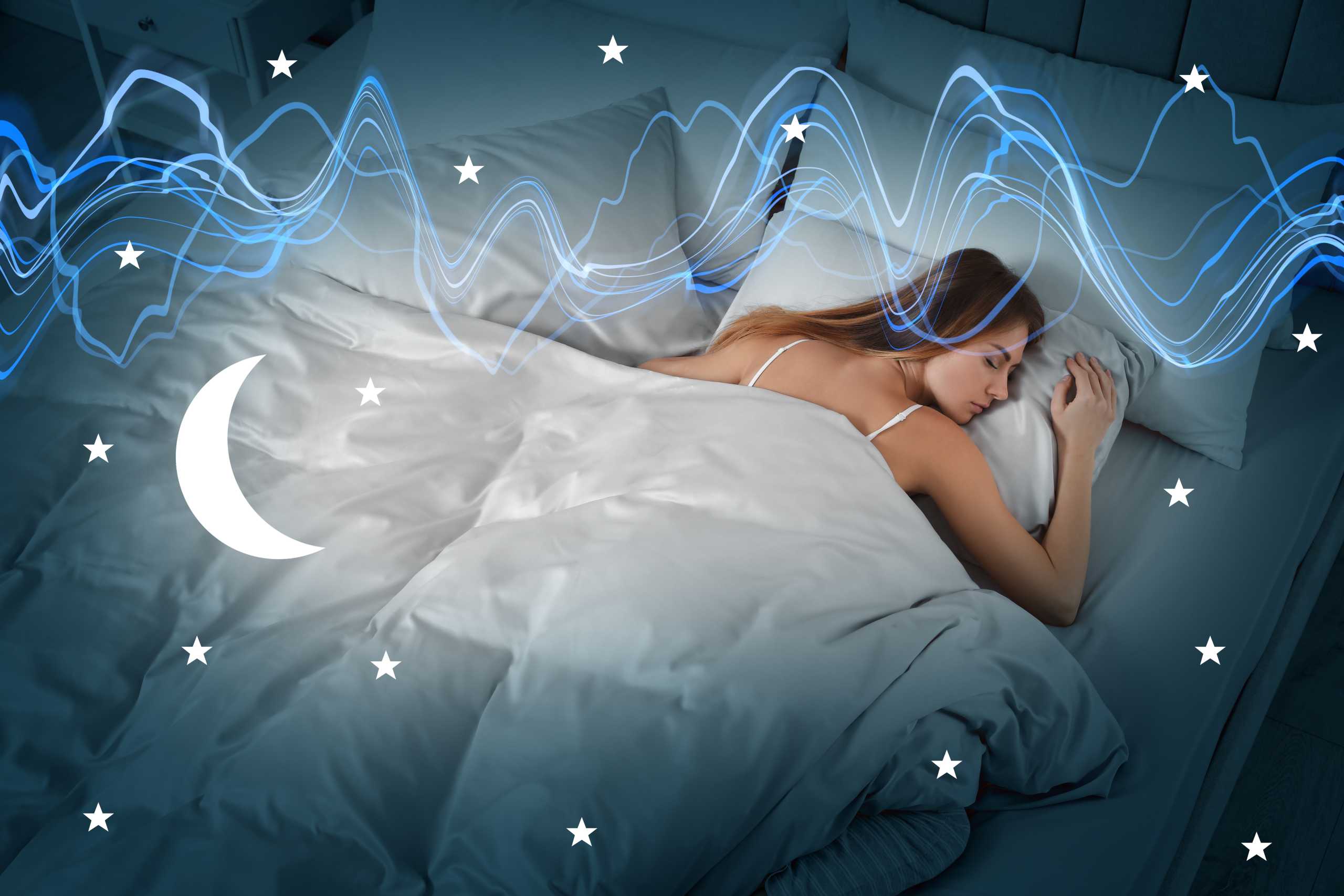Dive into the rhythm of your internal clocks and uncover how these cycles orchestrate your sleep, mood, and metabolism. In this exploration, we’ll uncover the fundamentals of circadian rhythms, shed light on disruptive lifestyle habits, and reveal the profound impact of their disturbance on our mood, weight, sleep quality, and even our vulnerability to diseases like cancer. Discover the transformative power of three essential lifestyle shifts that recalibrate your circadian rhythm, unlocking energy, vitality, and overall harmony.
Let's Get Started:
What are Circadian Rhythms
All life on earth has adapted to the natural 24-hour day-night cycle. Our hormones, energy levels, mental clarity, immunity, body temperature, and digestion, follow a 24-hour cycle to ensure our body’s internal processes work in harmony. These synchronized cycles, collectively known as circadian rhythms, activate and deactivate various bodily functions at specific times to align with our daily needs.
Synchronized circadian rhythms optimize energy usage, sleep, repair processes, and overall vitality. Desynchronized circadian rhythms increase our risk of cancer, disrupt sleep patterns, immune responses, cognitive function, hormone regulation, blood pressure, digestion and energy levels, significantly impacting overall health and well-being.
Circadian Clocks: Brain and Beyond
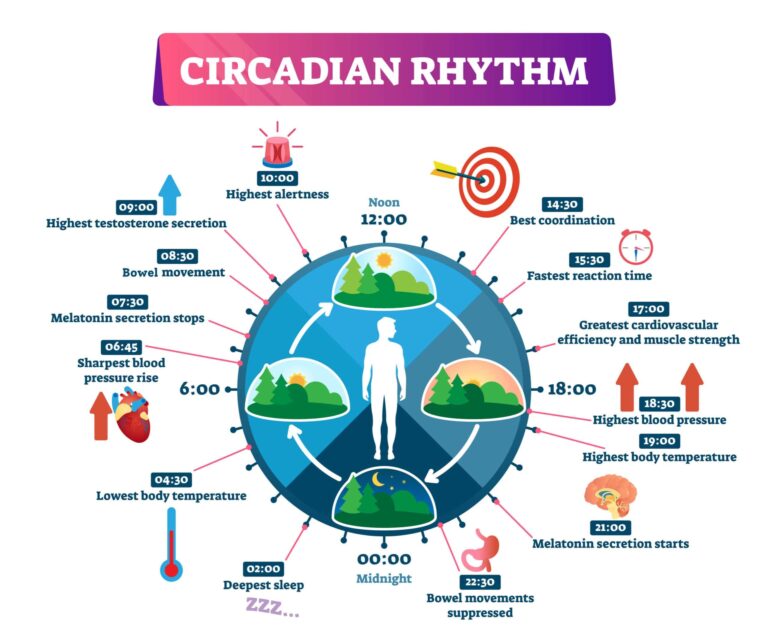
How does the body manage multiple rhythms, each peaking and fading at different times, to optimize metabolism and vitality? Enter the conductor of your circadian rhythms: the suprachiasmatic nucleus (SCN), nestled within your brain.
Your SCN, often called the master clock or central pacemaker, responds to sunlight or its absence, signalling your body to wake up or wind down for sleep. When early morning blue light reaches your eyes, specialized light-sensitive cells in your retina (melanopsin) send signals to your SCN, marking the beginning of the day. Your SCN then triggers the production of serotonin, known as the ‘feel good’ hormone, and cortisol. Cortisol enhances alertness, drawing from energy reserves and boosting cognitive function, preparing both body and mind for the day’s tasks.
As long as sunlight stimulates your melanopsin, serotonin production stays high. However, as the sun sets, the diminished light signals our brains to convert serotonin into melatonin, priming us for sleep.
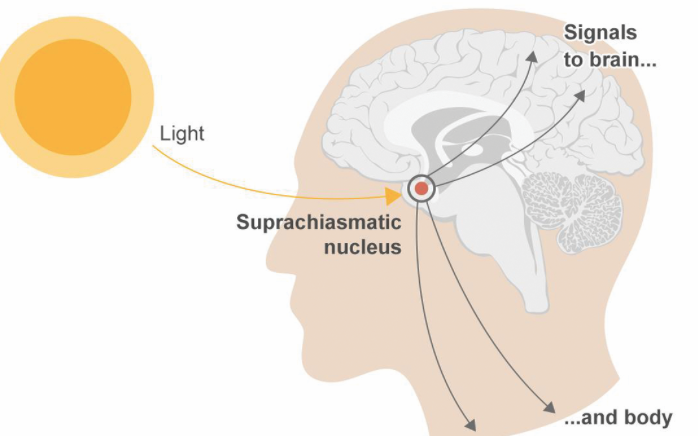
Key Point: Your SCN, reacting to sunlight or its absence, orchestrates the primary circadian rhythm of your body—waking you up and kickstarting your system before winding down as darkness approaches for sleep later on.
Beyond the brain’s master clock, controlled by your SCN, other organs like the liver, lungs, heart, intestines, and kidneys operate on their own circadian rhythms governed by local genes like Clock and BMAL1. These internal rhythms aim to synchronize with the SCN’s signals but also respond to local cues such as meal times and activity levels.
Imagine this: as the sun sets, your SCN signals your body and all your metabolic processes to wind down for sleep. Sleep is essential for your body to eliminate toxins that build up during daytime activities. However, if you then eat a substantial meal or have a late-night snack, your digestive system has to ramp up, as does your liver and pancreas, to process the food. How efficient can your body or any system function when it gets mixed signals to wind down and wind up?
The more these minor rhythms/clocks align with your SCN day-night cycle, the easier, more efficient, and less effort it takes to eat, sleep, think, and move.
Key Point: Synchronize all your circadian rhythms for more Effortless Living.
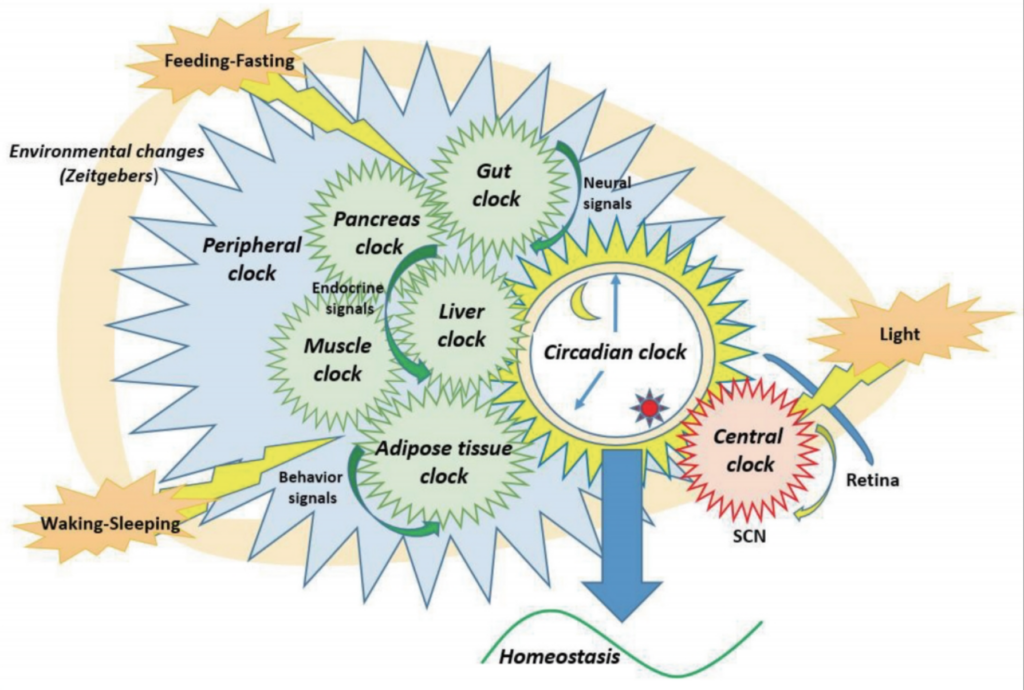
The Ripple Effects of Circadian Rhythm Disruption
Disrupted circadian rhythms, known as chronodisruption, trigger a collapse in our body’s balance (homeostasis) and carry significant health implications. Chronodisruption markedly increases the risk of various cancers (including breast, prostate, and colorectal), cardiovascular complications, metabolic syndrome, obesity, mental health disorders (depression, dementia, insomnia), IBS, and gut dysbiosis while also impacting immune system functionality.
How do behaviours that disrupt circadian rhythms heighten our risk of cancer? Our immune system functions on a 24-hour rhythm, explaining why your temperature is typically higher in the late afternoon and why you feel worse in the late afternoon when you are ill. When circadian rhythms are disrupted, the immune system’s efficiency decreases, making it harder to recognize and eliminate abnormal cancer cells. The link between chronodisruption, shift work, and cancer is so pronounced that the International Agency for Research on Cancer (IARC) and the WHO classify night shift work as a human carcinogen!
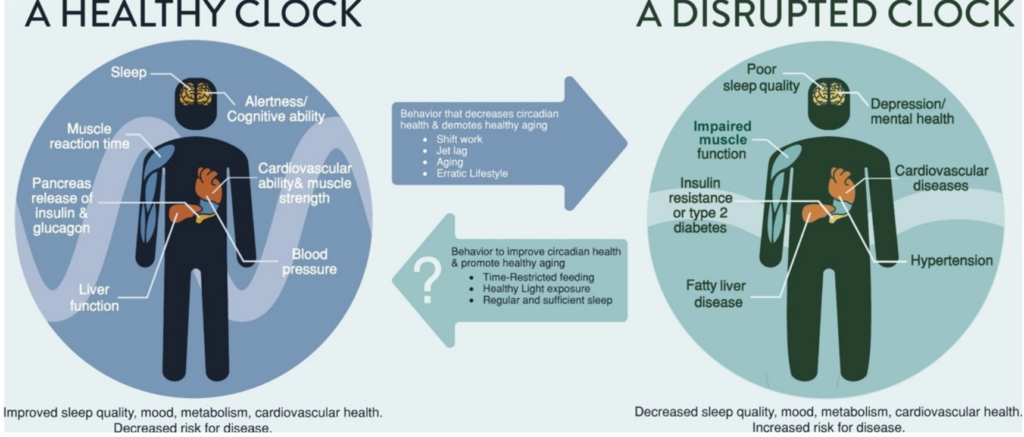
Resync Your Circadian Rhythms: A 3-Step Guide
Three essential steps are vital for aligning your circadian rhythms for optimal health:
1) Sync with Sunlight: Align the beginning of your day with morning light and your wind-down time and sleep with dusk and night.
2) Harmonize Your Habits: Coordinate eating, exercise, thinking and sleep to match this day-night cycle.
3) Establish & Maintain Consistency: Forge a routine that mirrors these natural rhythms and uphold it steadfastly for optimum outcomes.
Let’s delve deeper into these steps plus learn how to apply them to minimize both jet lag and social jet lag. Additionally, we’ll touch on the evolving field of circadian lighting, particularly beneficial for individuals in low-winter light environments or navigating shift work challenges.
1) Sync with Sunlight
Embrace the morning’s blue light, particularly the activating 480nm wavelength, most prevalent around an hour after sunrise, to stimulate your body’s activity and circadian rhythm. Step outside without glasses, armed with coffee, a yoga mat, or your workout gear.
Glass blocks UV and some blue light, so being outdoors amps up your exposure. Adjust time outdoors based on sunlight intensity—aim for 10 minutes on clear mornings and longer on cloudy days. Consider utilizing early prototype circadian lights or SAD Lamps to simulate early morning sunlight upon waking during the dark winter mornings.
Throughout the day, take periodic sunlight breaks to maintain energy and alertness. Catch a sunset if you can; the transition from high-energy blue light to lower-energy reds and infrareds in a sunset signals your brain to convert serotonin into melatonin, preparing you for sleep.

Before bed, avoid stimulating blue light from screens, as it disrupts melatonin production. Consider blue light-blocking glasses and warmer LED lights for evening use. Craft a sleep haven: dim or cover lights, reduce noise, and maintain a cool (18+/-2 degrees C or 65 degrees F), quiet bedroom.
Key Points: Maximize daytime vigour with early morning light and regular sunlight breaks. Optimize sleep by emulating the night’s quiet, cool darkness and limiting stimulating blue light during your wind-down.
2) Harmonize Your Habits
Exercise, eating, and thinking are activities that influence your peripheral clocks. Aligning these activities with the day/night cycle will enhance vitality, reduce friction, and promote more effortless living.
Exercise is a power-up, especially when bathed in early morning blue light, amplifying its benefits. Steer clear of exercise 2-3 hours before bedtime.
Optimize your digestive system’s 24-hour cycle. Irregular meal times disrupt this rhythm, affecting your microbiome and potentially leading to issues like IBS. Your gut, like your brain, needs synchronization—activity by day, rest by night to flush out toxins. Obesity ties closely to these disruptions, highlighting the importance of meal timing. Try heavier meals earlier, lighter later. Avoid eating an hour after waking and refrain from food three hours before bedtime. Explore time-restricted feeding for a healthier rhythm.

How can chronodisruption lead to obesity? Disrupted body clocks may prompt late-night eating, causing the body to store more food as fat due to slower metabolism during sleep. It also disrupts key hunger hormones, like leptin and ghrelin, potentially increasing appetite and promoting weight gain
Have you ever observed your thought patterns throughout the day? Stressful thinking triggers the release of cortisol and adrenaline. Reserve intense mental tasks, such as work emails or other demanding cognitive activities, for the daytime and aim to relax your mind as the evening approaches.
Key Points: Exercise, eating and stressful thinking activate you; align them during the day and avoid them during the evening and night.
3) Establish and Maintain Consistency
Building and adhering to a routine is crucial for aligning your circadian rhythms and optimizing your health. Your body’s metabolic processes thrive on a 24-hour cycle and crave routine to synchronize effectively.
Set a consistent wake-up time, meal time, exercise windows, wind-down rituals, and bedtime routines. It might take a few weeks for your body to sync up, but once your routine is ingrained, occasional deviations—like a late night with rich food or a sleep-in Sunday morning have minimal impact on your synced rhythms, but remember, it’s essential to establish that routine first.
Effective Strategies to Combat Jet Lag

Jet lag occurs due to a sudden disruption of your circadian rhythms. To minimise jet lag and swiftly resync your internal clocks, align everything that influences your circadian rhythms, like light exposure, meal times, activity, mental engagement, and sleep, with your destination time zone. Aim for this alignment before departure or, at the very least, at the airport. Consistency is key.
Remember, light is the most powerful force regulating your circadian rhythm. If it’s nighttime at your destination, reduce light exposure at the airport and during the flight (using sunglasses or eye covers). Opt for a light meal, like pasta, at the airport. Skip dinner on the flight, aiming to sleep aided by shades, earplugs, and melatonin.
Long-haul flights typically serve breakfast that aligns with morning time at your destination. Opt for the highest protein/fat breakfast to activate your digestion. Open the window, play games on your computer; you want to maximize light exposure and try to stay active. Upon arrival in daylight hours, spend your day immersed in ample light, stay active, and eat high protein/fat meals during the day.

As evening nears, opt for a lighter early evening meal and reduce your light exposure. Make your new bedroom totally dark, cool and hushed.
Consider using an app like “Timeshifter” or “Jet Lag Rooster”; they provide personalized plans tailored to your travel details, facilitating a smoother adjustment to a new time zone.
Social Jet lag: What you Need to Know
Social jet lag arises when our sleep and wake times differ between workdays and days off. Like regular jet lag, it disrupts our circadian rhythms.
Our sleep preferences, called chronotypes, determine whether we are early birds or night owls. These preferences are influenced by genetics and tend to shift as we age. While younger adults often lean toward being night owls, most become early risers with age. However, societal schedules, primarily designed for early risers, can challenge the sleep patterns of night owls, causing various health issues such as weight gain, heart problems, mood swings, and cognitive difficulties.
To address this disparity, some institutions, particularly schools, are adjusting their start times, especially for teenagers, recognizing the benefits of accommodating their natural sleep patterns. For individuals with flexible work schedules, aligning their sleep-wake cycle to their chronotype is crucial, keeping in mind the three steps for circadian realignment:
- 1) Sync with sunlight.
- 2) Align activities with the Day/Night cycle.
- 3) Establish and maintain consistency.

Indoor Lighting and Circadian Rhythms: Key Considerations
Energy-efficient LED lighting, widely adopted for cost savings, poses health risks due to its high blue light content. While beneficial for alertness, this light disrupts circadian rhythms after dark. Because of this, scientists are now advocating for warning labels on high-blue-light LEDs, especially for evening use.
As concerns surrounding the impact of artificial lighting on health increase, a new category of lighting technology is taking center stage: circadian lighting. These advanced lighting systems are crafted to support the natural circadian rhythms of the human body. Circadian lighting achieves this by adjusting the intensity and wavelength of light throughout the day, providing brighter, cooler, blue-enriched light during the day, which gives way to warmer, dimmer tones in the evening to simulate the natural progression of sunlight. Key players in this domain include Philips Lighting (Signify), Ketra, BIOS Lighting and SkyView.

For those who may not have access to circadian lighting systems, practical steps can still be taken to harmonize indoor light exposure with your body’s circadian rhythm. During morning hours, maximize exposure to natural daylight and use SAD lamps if it’s still dark outside when you wake. As the day transitions into evening, minimize exposure to blue light by dimming your lights and using bulbs with a warmer color temperature. Consider blue light-blocking glasses in the evening (not during day) if you don’t control your lighting. By consciously adjusting your light exposure, you can support your internal clock and enhance your circadian health.
Summary
In our modern era, the prevalence of shift work, frequent jet lag, social jet lag and prolonged indoor living has sparked a 21st-century phenomenon: chronodisruption, the complete desynchronization of our innate biological rhythms.
From a physical standpoint, our bodies resemble machines —how efficiently does a machine operate, and how long does it last when different parts are simultaneously revving up and winding down?
The path to realignment involves three fundamental steps. Firstly, embrace sunlight upon waking and wind down with darkness, aligning with the body’s natural cues. Secondly, synchronize daily activities—such as eating, exercising, and thinking—with the wake-sleep cycle. Finally, establish a personalized routine that suits your lifestyle, emphasizing consistency and a regular sleep schedule.
Remember, your Life is your unique Journey. Let Health be your Guide.
